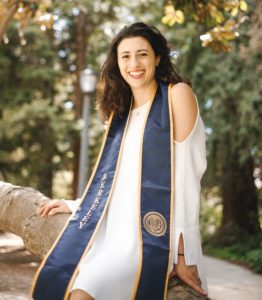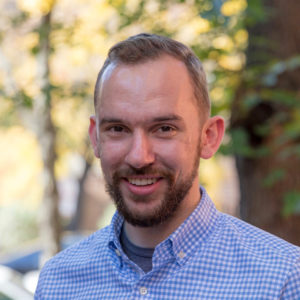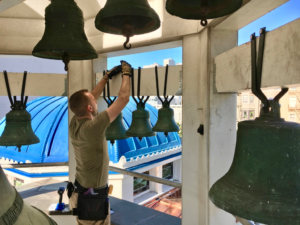Orthodox Music in America’s 40 Under 40: Markayla Stroubakis
There is a generation of Orthodox church musician in America that is not only growing up, but also taking their place in a legacy. They are maturing into the musical leaders at the very parishes that they grew up at, and filling the spots their teachers once held, continuing their teachers’ work for the next generation.
Markayla Stroubakis, of Ss. Constantine and Helen Greek Orthodox Church in the San Diego area, is one such church musician. She is the cantor at the very church she sang at as a child, directing from the analogion at which she used to stand next to her teacher. She also is part of a generation of musician whose development was influenced by the recordings of Orthodox music by professional ensembles like Cappella Romana, and has since had the opportunity to sing with those groups as an adult. Not only that, but her passion for including and educating the youth in the music of the Orthodox Church suggests that the legacy will not end with her.
We spoke to Markayla by phone on May 10 2020.
Markayla Stroubakis.
And your date of birth?
June 4, 1996.
What you do and where you do it?
I am the protopsaltria at Saint Constantine and Helen Greek Orthodox Church in San Diego, California. I lead the chanting, I do some introductory teaching, and I also direct a children’s choir, which was handed down to me from my predecessor and teacher Alex Khalil — it’s actually a choir I used to be a part of! I’ve led the chanting for the last two years, and for four years before that I led with Alex. I’ve been singing ever since I was in elementary school — I sang in choirs, and Western music was and is something that I really, love. I took voice lessons for years throughout high school and college, and in high school I sang in five or six choirs.
In the seventh grade, I started singing in the choir at my parish because frankly, I couldn’t focus without having something to do. It was kind of a good way for me to keep myself occupied during, you know, an hour and a half of liturgy. When I was fifteen, Alex had been at our church for a couple of years, and he approached me, asking, do you want to learn how to chant? I had never knowingly heard Byzantine chant before, but I said sure. Alex started picking me up from my house on Sunday and taking me to church with him for Orthros — and I later figured out that was 30 minutes out of his way. I began by standing there at the analogion, mostly just watching Alex and listening to him. Sometimes I’d be able to sing simple “Lord have mercy” responses, and then after a while things like “God is the Lord,” mostly on the spot. I was singing with Alex like that until I was a senior in high school.
After I graduated, I went to UC Berkeley for college, and I sang in Marika Kuzma’s Chamber Chorus there. In general, living in the Bay Area was a cool way for me to get acclimated to chanting with other people. I was hopping around to different churches and chanting everywhere I could and I kept that going while I was in school; it was a great opportunity to get to know people like John Michael Boyer, who was living in the Bay Area at the time.
After I graduated, I came back down to San Diego; I sang with Alex again for a while, which was awesome. A year and a half ago, Alex left to take an ethnomusicology position at University College Cork in Ireland, and when he left, I took his position.
Beyond that, I’ve had the opportunity to sing with Cappella Romana; in December 2017, they programmed “Sun of Justice,” a Christmas concert of Byzantine chant, and it was the first time they had used women and men all singing from scores in Byzantine notation. That was fun, being in Portland for a week for rehearsals and then doing shows there, Seattle, and in Northern California. It was a amazing thing to be a part of that.
Something else I’ve taken on at Ss. Constantine and Helen is a youth choir that sings at the Folk Dance Festival, the big youth event of the Metropolis of San Francisco and the Archdiocese. There’s a big choral competition that’s a component of FDF, and one of the categories is liturgical music and folk songs; you have to prepare 12 minutes of music with at least two pieces from those categories. I sang in the competition choir as kid, and Alex, who knows a lot about teaching kids, did a lot to raise the bar with us in terms of Byzantine music, plus he was also able to have us sing folk songs with a whole band that included bouzouki and clarinets and drums and tambourines.
Now I’m directing that group, with ongoing input from both Alex and my friend Emily Laliotis, who also sang in the group as kid, has taught children’s choirs before, and who’s good with vocal pedagogy. We’re not teaching the kids Byzantine notation at this point, we’re having them learn by rote. They’re incredible with learning music and words; last year they were able to learn Psalm 102 in Greek from the Typika and perform it from memory, and that’s a fast, wordy piece, and they’ve also been able to learn the eight-mode Doxastikon from the feast of the Dormition, as well as folk songs. This year was special because we sang for Archbishop Elpidophoros, who’s very excited about the youth. The kids did an amazing job, and the Archbishop made a point of telling our group how appreciative he was of what they did.
Alex was instrumental in laying the groundwork, but our kids just learn music so fast — they are so amazing in that way. It can be hard to get kids to sing at the analogion because the boys might be serving in the altar or they’ve got Sunday School or something along those lines, but before COVID-19 we were getting to a point where some of the girls would sing. It’s a challenge to get all the kids together in one place, but they love the music and they love singing with each other.
What was it like to learn Byzantine music at a young age and in that setting from a teacher like Alex?
I feel so incredibly lucky and grateful to have learned from Alex because Alex was always and continues to be extremely patient with me. He explains things in a way that it’s never condescending, and he’s able to hone in on my problems.
When I started learning Byzantine music at fifteen, I had already developed a skill set with Western music. I considered myself to be a very good sight reader, I was very proficient in solfege, I was taking AP music theory, and I had an incredible choir director I had learned a lot from in regards to Western music. So with Byzantine music, I started to make associations where I felt associations could be made — I’m good at pattern recognition, and I was able to absorb theseis [the paradigmatic component phrases, or formulae, of Byzantine music] fairly quickly and associate them with how they looked in the notation. I was able to develop a good understanding of the modes. It helped that Alex was constantly putting me on the spot; I’m a perfectionist, and I don’t like for people to hear me when I haven’t practiced or when I don’t know something, so Alex challenged me always to be on my game. Eventually, if Alex was out of town for a conference, I would lead Orthros all by myself, and I would challenge myself to use the music rather than wing it and make something up from the text. I had to listen and practice a lot, but now it’s almost second nature.
I’m fortunate that Alex taught me to be confident and self-assured at the analogion — he taught me never to be afraid and never back down, even when I’ve been trampled on in various circumstances. He respected me, and in turn, I want kids to feel confident and to feel like they’re respected up there. If the kids, especially the girls, see somebody chanting they can identify with, I think it probably makes it easier for them to feel comfortable and confident coming up — especially if what has been most typical is an older man being up there by himself.
What motivates you to do what you do?
I grew up Orthodox and going to church, but it wasn’t until I started singing Byzantine music that I started to feel a connection to the Church and to Christ — a connection that I had not experienced before. For me, a large part of singing Byzantine music for me is experiencing Christ’s love in worship. That’s a big motivator for me, because like I said, as a kid it was hard for me to focus in church, to sit there and be prayerful in church without singing. Music has always facilitated my focus and thought — first Western music, and now with Byzantine music. That said — as a church musician, I approach what I’m doing as a sacrifice that allows other people to be more meditative and lose themselves in the worship, but I have to keep my focus on what’s happening in the service and make sure I’m doing my part of it.
Also, simply put, God is leading me in Byzantine music, and that motivates me to continue to work at this and get better at it for the glory of God. I sang a Cherubic Hymn in a master class once for John Boyer, and afterward, he said, “I can tell that you have such a deep love for this music in your heart.” And that almost made me cry because that’s absolutely true. Obviously, I’m still learning, but this is absolutely a calling for me, and I’m thankful for that. Byzantine music has made huge strides over the last five years, in my home Metropolis at least, and I feel like it’s my calling, my duty, to do this and to and to help propel church music along in this way.
Are there any projects you’re working on that you haven’t talked about yet?
Right now, with COVID-19 keeping us all inside, I’m mostly working on refining and improving some of my chant skills — rhythm, for example. I’m also working with Alex on my modal theory. Self development is key. Once things get back to normal, though, I have a concrete goal — I would like to have one Sunday a month as Youth Sunday, with the entire liturgy to be chanted by youth. When Alex left, he left scores in Byzantine and Western notation for that purpose, and it’s well within the kids’ reach to do that. I want to do more than just training kids for a competition, because while that’s great and it gets them exposed to the music and singing challenging repertoire, they need to do it in church first and foremost. I want more involvement from the kids during Divine Liturgy, and I want to get over the logistical barriers that stand in the way.
Beyond that, I want to go to Greece and spend some time learning from a teacher there.
What projects do you want to work on that nobody’s asked you to do yet?
I want to be involved with another Byzantine choir project, for touring and performing. Obviously, that’s not on the menu any time soon, but I want to do something where I can sing with other people. We so rarely get time! When you’re a chanter with a church position, you don’t get to go anywhere else to sing, because you have the responsibility to be at your parish on Sunday. I hope to have opportunities where I can sing with other chanters for concerts and events.
Every time you sing with someone who is better than you, you learn something, and that can be difficult for the working parish chanter — we always have to be there. And especially with my teacher in Ireland — like I said, I was in Ireland this past summer working with Alex, but that wasn’t enough. I miss having those opportunities, and I would like to make more of them.
What is your sense of the big picture for Orthodox music in America?
Looking at it just from the standpoint of my home Metropolis — the Greek Orthodox Metropolis of San Francisco is going through a large shift. Byzantine music is being more widely incorporated across the board in a way that wasn’t the case before. The Choir Federation seems to be embracing it more, and different chanters up and down the West Coast are making a good case that Byzantine music is more accessible. I mean, I come from a Western music background, as I’ve said, I grew up with settings like Frank Desby’s, and Desby’s liturgy is, I think, incredibly beautiful. But for where we’re at right now, choral music like Frank Desby’s is hard. Being able to sing four-part music beautifully is hard. The ranges and the forces required are challenging — on the West Coast, in general, we just don’t have the numbers or the engagement and participation to be able to sing this music with the beauty it deserves. At my parish, we definitely don’t have the numbers, and we don’t even have even one tenor. There are absolutely parishes that are still able to do it; there’s an incredible four-part Western choir at Ascension Greek Orthodox Cathedral in Oakland, CA. But, if we don’t have the ability to sing that music well, we have to find other ways of making music ministry work for people. Otherwise, we’re stumbling through everything, it just doesn’t sound good, and you lose the musical beauty. With mosaics and icons and the other physical aspects of the church, that beauty is there, it’s physical. It’s there, it’s permanent. But we have to pay regular attention to the music, because it’s something the people do on an ongoing basis, and day to day things are going to change — even half hour to half hour as people get vocally tired during a service. That means we need to meet people where they’re at, and I am trying to get people to see the beauty of what’s available to us in Byzantine music. You don’t need four part choral music to sing a beautiful Divine Liturgy; you can sing a beautiful, unison Divine Liturgy with Byzantine music.
But then, the other part of that is that a lot of the chanters who have been around for a long time are getting older and starting to retire. They’re not able to stand as long, their voice is not as strong as it once was. So it seems like those of us who are young and are full of pep and vigor have a responsibility to pitch in and do our part — otherwise, we’re going to find ourselves in a scenario where the music of our church is going to be a choir of three people who kind of know the Desby soprano part and that’s all they can do.
Even talking about congregational singing — Byzantine music is a lot more accessible for congregational singing than some people think. Congregations in my experience can’t sing Desby; the notes are too high, for one thing. But in my experience, Byzantine music is easier for everybody to participate in, everybody can sing along, and I always hear people singing from the pews during a Divine Liturgy with Byzantine chant. To me there’s no question that it’s accessible and that it’s music that can bring us together to worship. If we make our worship more accessible, then we’ll make Orthodox Christianity more accessible in general.


